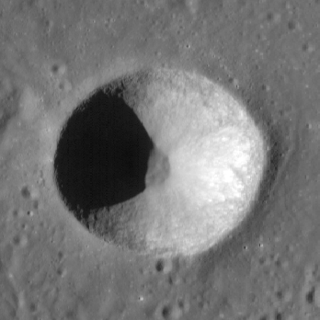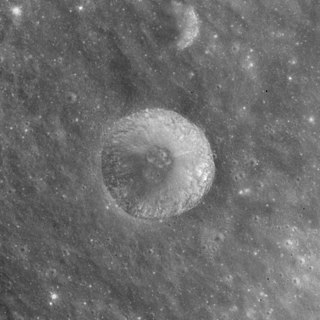
Artsimovich is a small lunar impact crater located in the western Mare Imbrium of the Earth's Moon. This is a circular crater forming a cup-shaped excavation in the surface of the lunar mare. It is named after Soviet physicist Lev A. Artsimovich. To the east is the crater Diophantus and to the northeast lies Delisle. Less than 20 kilometers to the north-northeast is the tiny Fedorov. This crater was identified as Diophantus A before being named by the International Astronomical Union.

McDonald is a small lunar impact crater located in the central Mare Imbrium. It was named after American benefactor William Johnson McDonald and Scottish selenographer Thomas Logie MacDonald. This crater is a cup-shaped feature with a circular rim, and has not been significantly eroded. It lies to the southeast of the slightly larger crater Carlini, in an isolated part of the mare.
Abetti is a lunar impact crater that has been completely submerged by mare lavas. It forms a 'ghost crater' in the surface, showing only a curved rise where the rim is located. Abetti is located near the southeast edge of Mare Serenitatis, to the west of the Mons Argaeus. This crater is generally visible only at low angles of illumination. It is named after two Italian astronomers, Antonio Abetti and his son Giorgio.

Deseilligny is a small lunar impact crater in the southern part of the Mare Serenitatis. It was named after French selenographer Jules Deseilligny. It is located to the east-southeast of the crater Bessel. Deseilligny is a bowl-shaped crater with a low rim. It is otherwise undistinguished.

Finsch is a relatively small lunar impact crater in the mid-part of Mare Serenitatis that has been almost completely covered by the mare, forming a ghost crater in the lava plain. It was named after German zoologist Otto Finsch. It is located to the south-southeast of the crater Sarabhai and northeast of Bessel.

Fahrenheit is a tiny lunar impact crater located in the southeast part of the Mare Crisium. This area of the surface is nearly devoid of impact features of interest. To the east are the Dorsa Harker wrinkle ridges, and beyond them is Promontorium Agarum at the edge of the mare. The landing site of the Soviet Luna 24 probe is located about 15 kilometers to the southeast.

Biot is a small, bowl-shaped lunar impact crater located in the southern reaches of the Mare Fecunditatis. It is named after French astronomer Jean-Baptiste Biot."Biot (crater)". Gazetteer of Planetary Nomenclature. USGS Astrogeology Research Program. It is a circular formation with a sharp-edged rim that has not been significantly worn. The inner walls slope down to a relatively small interior floor. The albedo of the wide inner walls is higher than the surrounding lunar mare, giving it a light hue. To the southeast is the crater Wrottesley.

Abbot is a small lunar impact crater that lies on the rugged ground between the Mare Fecunditatis in the south and west, and the Mare Crisium to the north. It is a circular crater with a cup-shaped interior. The inner walls slope downward to the midpoint, and no impacts of significant mark the interior or the rim.

Acosta is a small lunar impact crater located just to the north of the prominent crater Langrenus, near the east edge of Mare Fecunditatis. To the west are the trio of Atwood, Naonobu, and Bilharz. Acosta is named after the Portuguese naturalist Cristóvão da Costa.

Asada is a small lunar impact crater located at the northern edge of Mare Fecunditatis, to the northeast of the crater Taruntius. It is a circular crater formation with inner walls that slope down toward a small central floor at the midpoint. Asada was designated Taruntius A prior to being named by the IAU.

Crile is a tiny lunar impact crater. It is roughly circular and cup-shaped, with interior walls that slope down to the midpoint. The crater lies in the Palus Somni, between the Mare Crisium to the east and Mare Tranquillitatis to the west.

Bessel is a small lunar impact crater that is located in the southern half of the Mare Serenitatis. The crater was named after the German astronomer Friedrich Wilhelm Bessel in 1935. Despite its small size, this is the largest crater to lie entirely within the mare. It lies to the north-northeast of the crater Menelaus.

Bohnenberger is a lunar impact crater that lies near the east edge of the Mare Nectaris, in the foothills of the Montes Pyrenaeus mountain range that forms the perimeter of the mare. To the east beyond the mountains is the larger crater Colombo. The crater has a low rim along the north wall, and the floor is somewhat irregular with a ridge crossing the floor. There is a small crater along the western inner wall.

Fedorov is a lunar geologic feature located in the western Mare Imbrium. It was named after Russian rocket scientist A. P. Fyodorov. It lies east-northeast of the crater Diophantus, and southeast of Delisle. About 20 kilometers to the south-southeast is the slightly larger formation of Artsimovich.

Bellot is a small lunar impact crater that is located on the southwest edge of Mare Fecunditatis. It lies between the craters Goclenius to the northwest and Crozier to the southeast. To the southwest is Colombo, and to the west is Magelhaens.

Darney is a small lunar impact crater that is located on the region of the Moon where the Mare Nubium joins the Oceanus Procellarum. It was named after French astronomer Maurice Darney. To the south is the lava-flooded crater Lubiniezky. The southern rim of Darney is attached to a series of low ridges that extend to the southwest.

Eckert is a tiny, isolated lunar impact crater in the northern part of the Mare Crisium. This crater forms a circular pit in the dark surface of the surrounding lunar mare. Just to the west is a wrinkle ridge in the mare surface, a feature that is prominent only under oblique lighting from the Sun. The nearest craters of note are Peirce to the west-northwest, and Picard to the southwest. Both of these craters lie in the Mare Crisium basin.

Courtney is a tiny lunar impact crater on the Mare Imbrium, a lunar mare in the northwest quadrant of the Moon. It lies about two crater diameters to the northwest of Euler, in an otherwise isolated stretch of the mare. The dark surface in this region is marked by Euler's ray material. The name is an English male name.

Couder is a small lunar impact crater that is located just behind the western limb of the Moon, in a region of the surface that is brought into view during favorable librations. It lies on the inner foothills of the Montes Cordillera, a ring-shaped mountain range that surrounds the Mare Orientale impact basin.

Chalonge is a lunar impact crater that is located on the far side of the Moon. It lies to the southwest of the larger crater Lewis, in the outer skirt of ejecta that surrounds the Mare Orientale impact basin. To the southeast are the Montes Cordillera, a ring of mountains that encircle the Mare Orientale formation.






















